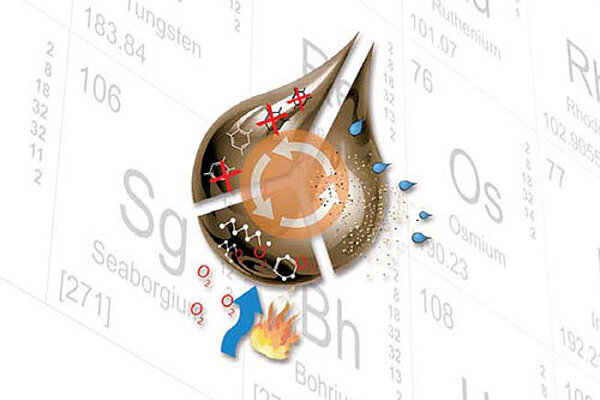Elements of a lubricant check
Fire, water, air and earth – well into the 18th century, alchemists believed there to be just four elements. In modern chemistry, 118 elements – from hydrogen to Oganesson – have so far been defined in the periodic system and classified according to various criteria. They are commonly divided into elements that form metals and constitute the bulk of the periodic table, non-metals and the intermediate category of the metalloids.
For good reason, the quantitative determination of the elements present in lubricants lies at the heart of lubricant analysis. After all, there is no oil, grease or assembly paste that does not occasionally contain several metallic elements. Since no additive package and hardly any grease thickener can do without them, they are already present in factory fresh products. Used oils or greases contain even more elements/ These are mostly either wear-induced particles originating in the lubricated component, contaminants or constituents of another lubricant.However, no matter what their origin, an element analysis using an ICP or RDE device can detect practically all of them in a standard-compliant manner. OELCHECK laboratory reports list up to 30 separate elements in concentrations of mg/kg (ppm) – and thus far more than the 18 elements in the standard studies by competing laboratories. In addition, the PQ Index (Particle Quantifier) also makes it possible to distinguish between corrosive, non-magnetic metal wear on the one hand, and abrasive, magnetisable metal wear on the other.

Table of contents
The elements in the OELCHECK laboratory report
The OELCHECK laboratory report lists the elements only once, in the categories in which they are most commonly found: Wear, contaminants and additives. The origin of some elements cannot be clearly determined, however. These will be listed under the category where they are usually found in new oil. A typical example of such an ‚indeterminate element‘ is zinc. Very many HLP hydraulic oils include a wear-and-tear-reducing additive combination that contains zinc. However, zinc can also result from the wearing of zinc die-cast components. In addition, zinc can appear as a contaminant from zinc-plated components, paint coatings that contain zinc or vulcanised tubing materials. Using something close to detective work, the experienced tribologist then decides what caused an unexpectedly changed zinc value.
Wear, contaminants or additives?
Wear
Elements categorised as resulting from wear can form as corrosive wear, which is partly chemically dissolved in the oil, or as a result of mechanical-abrasive, particle-induced wear. The aim of the lubricant analysis is to evaluate the extent of the wear by the changes in the elements detected in a sample. With the help of the metals or metal combinations found in the sample, any unusual wear in the affected components can be so accurately categorised that a targeted on-site inspection of the relevant components, such as rolling or plain bearings, pumps, valves, pistons or cylinders, can be carried out.
Contaminants
Often contaminants can get into the lubricant in the form of dust. It will appear in the list of elements as silicon, which can however also be an anti-foam additive. Calcium – normally an additive – can also occur as contaminating chalk dust. Aluminium, which is usually a sign of wear, is a contaminant if present in the form of bauxite. In addition to water, residues from manufacturing processes, release agents, assembly aids or traces of other lubricants can also sometimes harm the oils. Synthetic oils in particular release contaminating elements from the components they are in contact with. These can be lubricated parts, but also filter elements, seals or coats of paint. Contaminants are almost always a potential hazard. They can accelerate the aging of the lubricant, cause foaming or encourage wear. One of the aims of each lubricant analysis is to detect contaminants as early as possible, so that any negative impact can be prevented by a timely oil change or treatment measures.
Additive
Under this heading, the laboratory report lists elements that were mostly added as organometallic (oil-soluble) combinations or – more rarely – as dry lubricants (MoS2). A comparison of the used oil values with new oil provides indications of possible additive depletion or mixing. Markedly changed values may point to a deterioration in the lubricant‘s performance.
Our analysis devices for optical emission spectroscopy (OES) produce very reliable values, because after every 10 analyses, a control standard is measured. However, an assessment should not be made on the basis of a single value. After all, machines, engines and systems must be viewed individually, taking into account their different conditions of use. All this contributes to our diagnosis of an oil sample. The values are additionally calibrated with other values in a statistical analysis that includes samples of the same type of machine. The OELCHECK database contains results of more than 2.5 million samples. In addition, our experienced tribologists can draw upon limit and warning values ascertained by them from 170,000 different machines for internal use. Nevertheless, statistical studies are always only tools. No two samples are identical. Their assessment relies strongly on trend observation and, ultimately, always the tribologist‘s expertise. There can be no fixed, universal and time-independent limits for contaminants or metals produced by wear, because these always depend on the machine‘s service life, as well the length of time the oil or grease has been in use. For this reason, the limit values and/or tolerance ranges published in our table should only be used as a general guideline for the service life and oil charge quantity that is typical of the use case in question. They are based on values from the OELCHECK database and our experience. As a rule, an estimate of individually identified values should take into account:
- the larger the oil quantity
- the shorter the service life
- for engines: the lower the engine speed;
- for hydraulic systems: the higher the working pressure
- for gearboxes: the higher the circumferential speed, the lower the limit values for wear-induced metals should be set.
And please remember: All values should be considered in terms of their interaction with each other!
The interpretation of the values
The experienced tribologist assesses all values in interaction and also takes into account the individual application conditions. The limit values or tolerance ranges published here can therefore only serve as a general guide for an application with a service life and oil fill quantity that are usual for this application:
- the larger the oil quantity
- the shorter the operating time
- for engines: the lower the speed
- for hydraulics: the higher the operating pressure
- for gearboxes: the higher the circumferential speed.
Additives and their changes should always be questioned critically, especially if they can indicate mixing with the wrong lubricant. If zinc is detected in a used oil that does not actually contain zinc as an additive, its origin must be determined in any case.
Contaminants, their warning values apply regardless of the operating time, oil quantity and loads. Too much dust is always too much!
Our tip: With one to two lubricant analyses per aggregate per year, you not only receive well-founded diagnoses by an experienced OELCHECK tribologist - but they also make trend developments visible. This not only provides you with a valuable tool for the early detection of wear.
OELCHECKER Spring 2015, page 4 - 5
OELCHECKER Winter 2014, page 3, 5 - 6




